My Mother’s Peasant Bread: The Best Easiest Bread You Will Ever Make
This post may contain affiliate links. Please read my disclosure policy.
This is the no-knead bread recipe my mother has been baking for 45 years. Start to finish, it can be ready in three hours. It bakes in well-buttered Pyrex bowls — no need to preheat a baking vessel for this recipe — and it emerges golden and crisp with a soft, tender crumb. 🍞🍞🍞🍞🍞
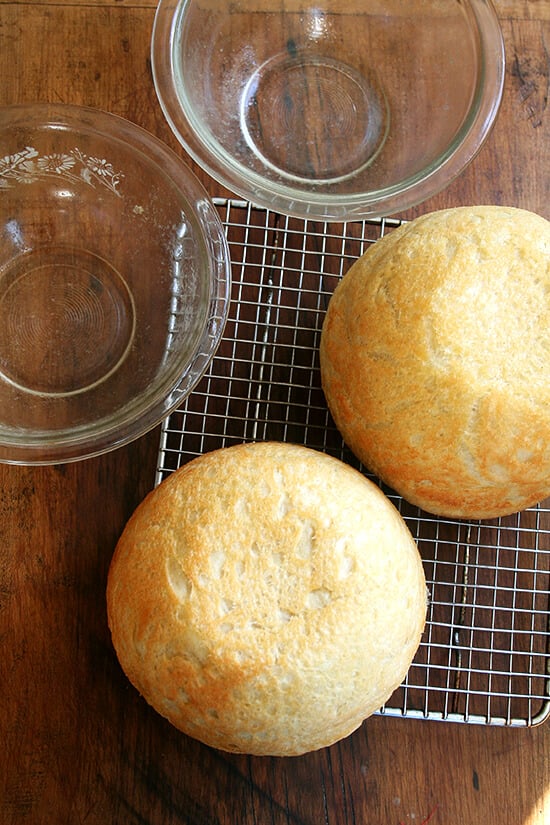
When I tell you that, if forced, I had to pick one and only one recipe to share with you that this — my mother’s peasant bread — would be it, I am serious. I would almost in fact be OK ending the blog after this very post, retiring altogether from the wonderful world of food blogging, resting assured that you all had this knowledge at hand. This bread might just change your life.
The reason I say this is simple. I whole-heartedly believe that if you know how to make bread you can throw one hell of a dinner party. And the reason for this is because people go insane over homemade bread. Not once have I served this bread to company without being asked, “Did you really make this?” And questioned: “You mean with a bread machine?” But always praised: “Is there anything more special than homemade bread?”
And upon tasting homemade bread, people act as if you’re some sort of culinary magician. I would even go so far as to say that with homemade bread on the table along with a few nice cheeses and a really good salad, the main course almost becomes superfluous. If you nail it, fantastic. If you don’t, you have more than enough treats to keep people happy all night long.
The Magic of the Peasant Bread
So what, you probably are wondering, makes this bread so special when there are so many wonderful bread recipes out there? Again, the answer is simple. For one, it’s a no-knead bread. I know, I know. There are two wildly popular no-knead bread recipes out there.
But unlike the others, this is a no-knead bread that can be started at 4:00pm and turned out onto the dinner table at 7:00pm. It bakes in well-buttered Pyrex bowls — there is no pre-heating of the baking vessels in this recipe — and it emerges golden and crisp without any steam pans or water spritzes. This is not artisan bread, nor is it trying to be. It is peasant bread, spongy and moist with a most-delectable buttery crust.
Genuinely, I would be proud to serve this bread at a dinner party attended by Jim Lahey, Mark Bittman, Peter Reinhart, Chad Robertson, Jeff Hertzberg and Zoe Francois. It is a bread I hope you will all give a go, too, and then proudly serve at your next dinner party to guests who might ask where you’ve stashed away your bread machine. And when this happens, I hope you will all just smile and say, “Don’t be silly. This is just a simple peasant bread. Easy as pie. I’ll show you how to make it some day.”
Peasant Bread Variations
Once you master the peasant bread, you can make any bread your heart desires — this simple no-knead bread recipe is the foundation of many of the other bread recipes on this site, namely this hugely popular overnight refrigerator focaccia and this simple homemade pizza dough. It’s even the inspiration behind this sourdough focaccia and this sourdough sandwich bread and this simple pita bread recipe.
The below post is organized as follows:
- How to Make Peasant Bread, Step by Step
- The Best Way to Store Bread
- Peasant Bread Dinner Rolls
- Peasant Bread Sandwich Bread
- How to Add Seeds and Nuts to Bread Dough
- How to Make Gluten-Free Peasant Bread
- How to Coat the Loaves in Seeds
- How to use Whole Wheat Flour
- How to Bake the Peasant Bread in a Dutch Oven
Many more variations on the peasant bread can be found in my cookbook, Bread Toast Crumbs:
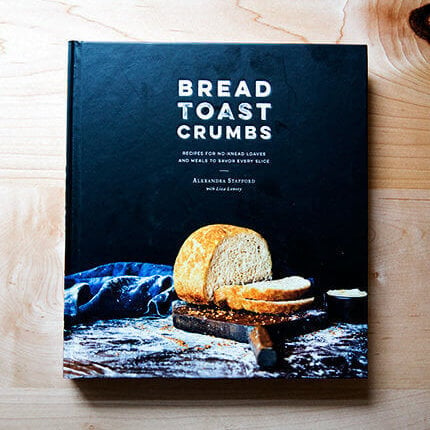
Bread Toast Crumbs
Love the peasant bread? There’s now a book filled with 40 simple bread recipes plus 70 recipes to use up every crumb of every loaf you bake.
How to Make Peasant Bread, Step by Step
First: You need yeast.
This is the yeast I buy exclusively: SAF Instant Yeast. Instant yeast can be whisked into the flour directly without any blooming or proofing. If you want to stick to active-dry yeast, there are instructions in the recipe notes on how to do so. Red Star yeast is great.

Whisk together flour, salt, sugar, and instant yeast. Add lukewarm water.
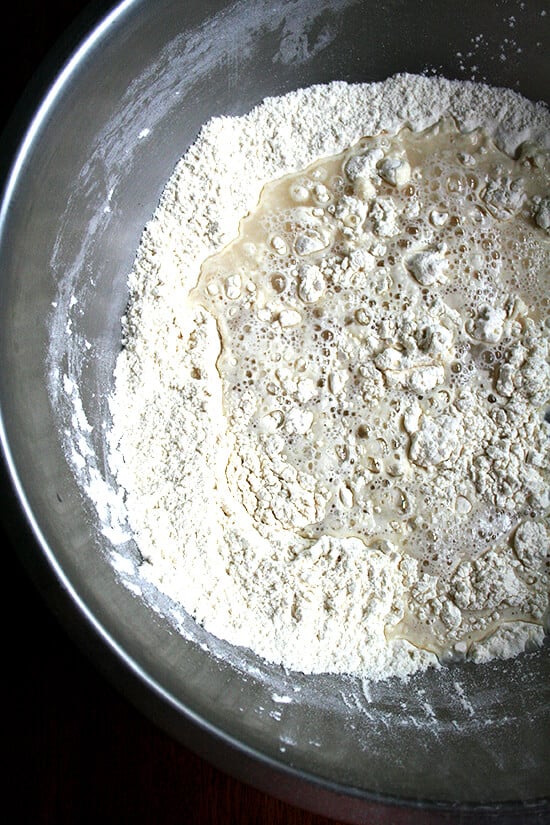
Mix until you have a sticky dough ball. Let it rise for 1.5 to 2 hours…
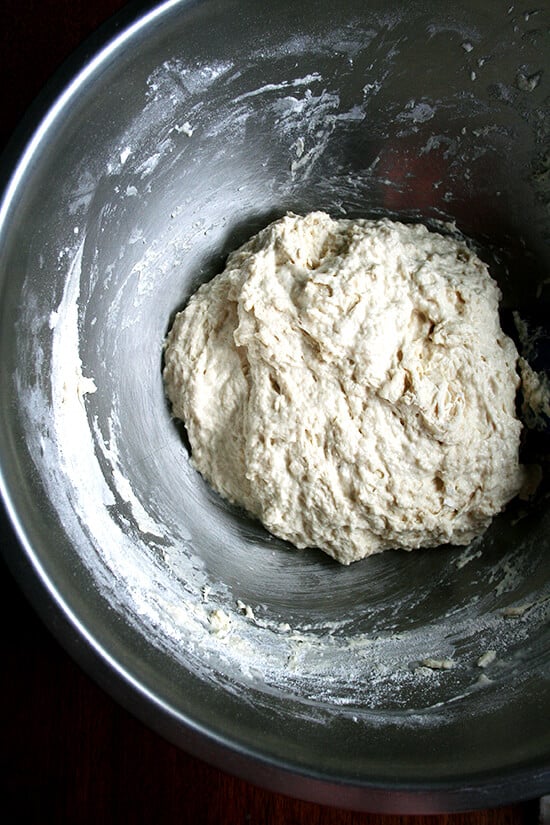
… or until it looks like this:

Punch down the dough using two forks.
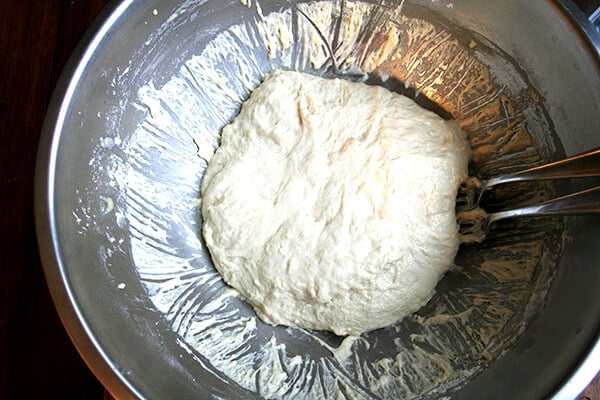
Then split the dough down the middle again using the two forks.

Because this is a very wet dough, it must be baked in an oven-proof bowl. I am partial to the Pyrex 1L 322 size, but any similarly sized oven-proof bowl will work.

Butter the bowls well; then transfer half of the dough to each prepared bow.

Let the dough rise again until it crowns the rim of the bowl, about 30 minutes.
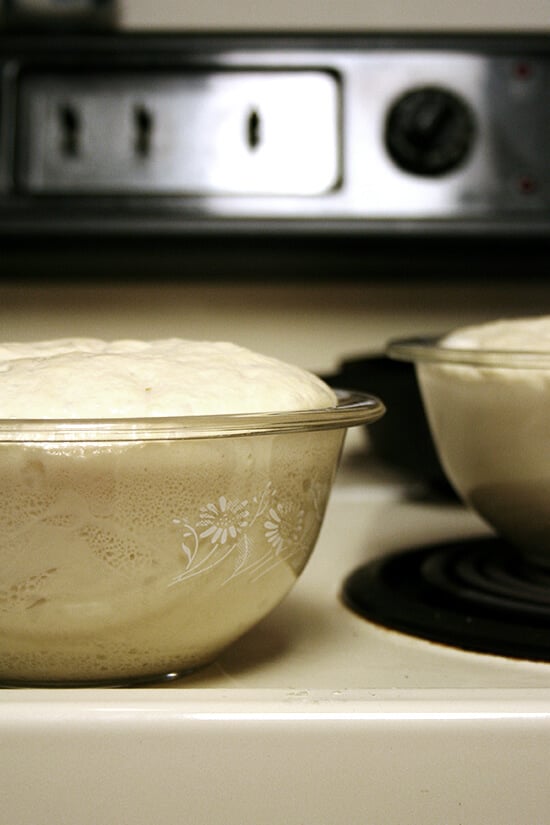
Transfer the bowls to the oven to bake:


This bread is irresistible when it’s freshly baked, but it also makes wonderful toast on subsequent mornings as well as the best grilled cheese. It’s also my favorite bread to use for these egg salad sandwiches and for this no-tuna “tuna” salad.

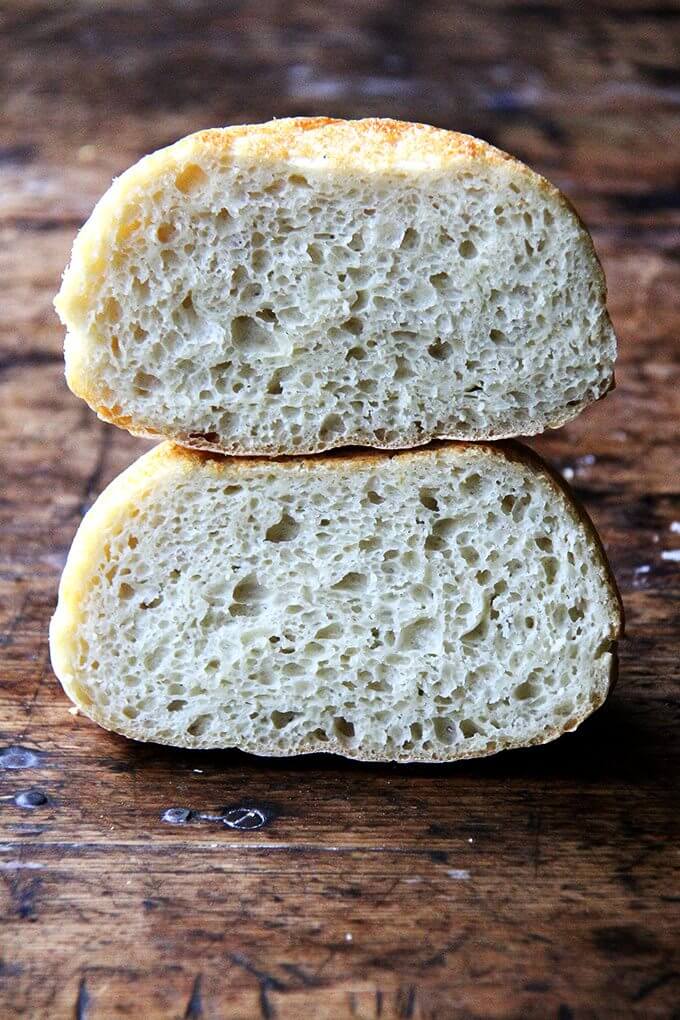
The Best Way to Store Bread
If you want to store the bread at room temperature for 3 to 4 days, I think the best method is in a ziplock bag. I’ve tried other eco-friendly options, but nothing seems to keep bread freshest — the crumb the softest — better than a ziplock bag. You can re-use the bags again and again.
If you intend to keep the bread for longer, I would freeze it. I often slice bread as soon as it cools completely, transfer the slices to a ziplock bag, then freeze. This way, I know the bread was frozen at its freshest.
A ziplock bag will not prevent the crust of bread from turning soft, which is why I suggest always reheating day-old bread. I use a toaster at breakfast for slices of bread, and I reheat half or quarter loaves in the oven at 350ºF for 15 to 20 minutes when serving for dinner.
Bread revives so beautifully in the oven or toaster.

No-Knead Dinner Rolls
To use the peasant bread dough to make rolls, simply divide the dough into smaller portions and place in a buttered muffin tin as in these No-Knead Thyme Dinner Rolls (pictured above). This recipe for no-knead buttermilk pull-apart rolls is also based on the peasant bread as are these brioche pull-apart rolls.
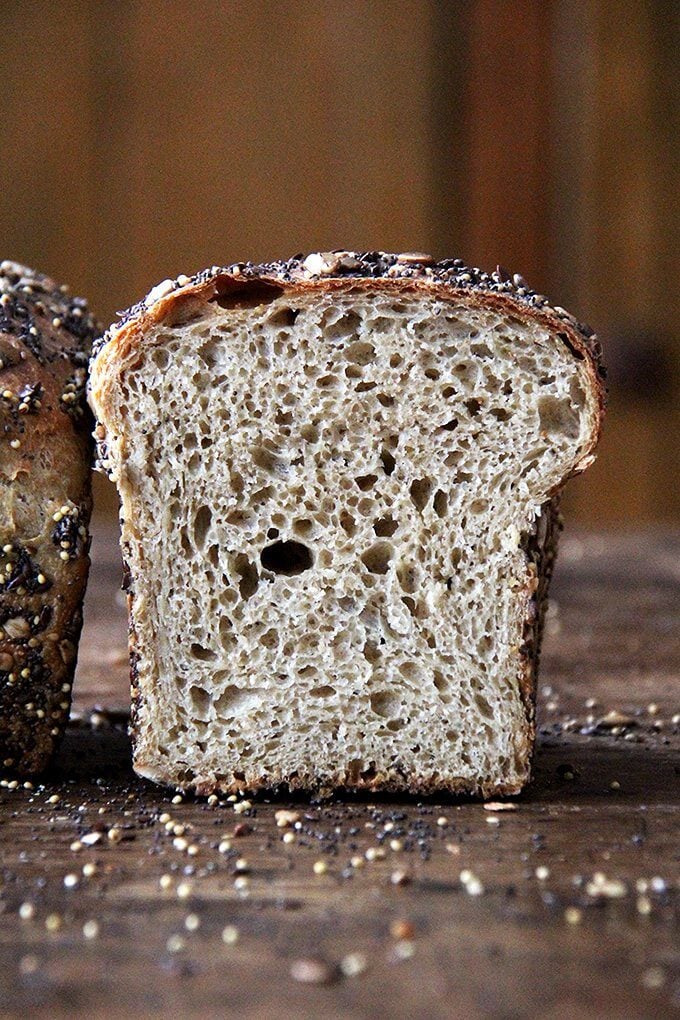
No-Knead Sandwich Bread
To make sandwich bread, multiply the recipe below by 1.5 and bake the bread in two buttered 8.5×4.5-inch loaf pans.
Made with half all-purpose flour and half King Arthur Sprouted Wheat Flour, these seed-coated sandwich loaves (pictured above) have a soft and light crumb. I really like KAF’s sprouted wheat flour, which is made from white whole wheat berries that, when sprouted, yield a creamy, sweet, milder-tasting flour. You can use 100% all-purpose or bread flour for an even lighter loaf or your favorite whole wheat flour in place of the sprouted wheat flour.
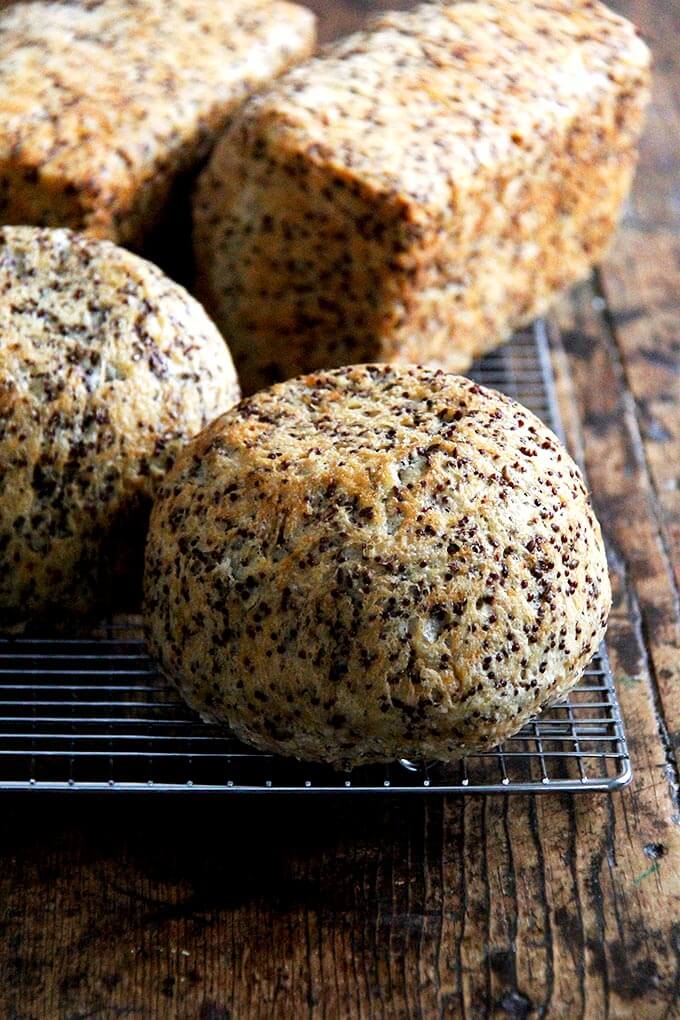
How to Add Nuts and Seeds to Bread Dough
To add seeds and nuts (or dried fruit and cheese), simply stir them into the dry ingredients. This recipe for Quinoa-and-Flax Toasting Bread will offer guidance on how much to add.

How to Make a Gluten-Free Peasant Bread
Making gluten-free peasant bread (pictured above) unfortunately isn’t as simple as swapping in gluten-free flour for the wheat flour. But the process and recipe is still super simple — in fact, because there’s only one rise, many people find the gluten-free peasant bread to be even simpler than the original. Find the recipe here: Gluten-Free Peasant Bread

How to Coat the Loaves in Seeds
To coat the peasant bread in seeds, as pictured above, simply coat the bowls with everything bagel seasoning or with dukkah or sesame seeds or whatever seed mix you wish. The seed-coated loaves look so beautiful, and it’s amazing how much the flavor of the coating permeates the loaves. Find the recipe here: Everything Bagel Seasoning Peasant Bread

How to Use Whole Wheat Flour
To use whole wheat flour in the peasant bread, simply replace as much as 50% of the all-purpose flour with your favorite whole wheat flour: I like KAF’s sprouted wheat flour, and I’ve been loving the Cairnsprings Mill Trailblazer stone-milled flour. With the Trailblazer, I can use up to 75% of it in the peasant bread, and it yields a beautiful, chewy texture as well as a lovely flavor and aroma.
When using whole wheat flour, you may have to use more or less water — there is no rule as to how much more or less, and it will take some trial and error to get right because all flours absorb water differently. When I use KAF sprouted wheat flour, for example, I don’t change the water amount at all. When I use the Trailblazer flour, on the other hand, I reduce the water by at least 50 grams.
If you’d like to learn more about whole wheat flour and stone-milled flours, read this: Easy Sourdough Bread (Whole Wheat-ish)
How to Bake the Peasant Bread in a Dutch Oven
If you’re looking for more of a crackling crusted boule (characteristic of a loaf of sourdough bread) as opposed to the buttery crispness of the peasant bread, you can bake the peasant bread dough in a preheated Dutch oven.
There are detailed instructions below the recipe in the notes section, but one thing to keep in mind before you begin is dough hydration. The peasant bread is a very high hydration dough, meaning there is a lot of water relative to flour. Because baking the peasant bread in a Dutch oven will require some handling of the dough — to shape it into a round and to create some tension — you may want to reduce the water from the start. Consider holding back 20-30 grams of water to make the process more manageable for you.
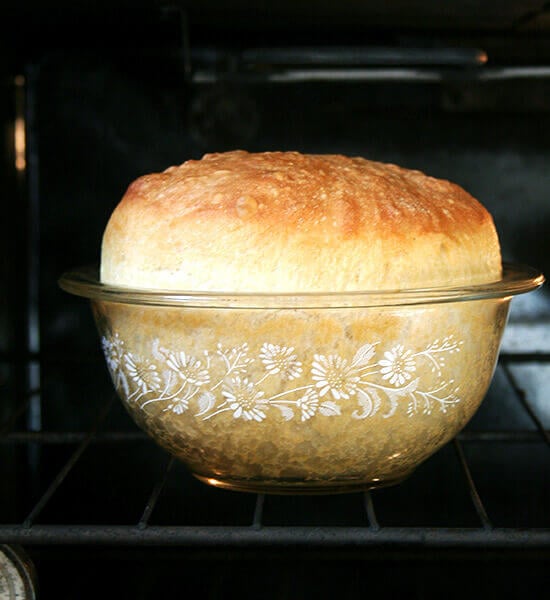
My Mother’s Peasant Bread: The Best Easiest Bread You Will Ever Make
- Total Time: 2 hours 27 minutes
- Yield: 2 loaves
Description
Notes:
The bread:
This is a sticky, no-knead dough, so, some sort of baking vessel, such as pyrex bowls (you need two 1-qt bowls) or ramekins for mini loaves is required to bake this bread. See notes below the recipe for sources. You can use a bowl that is about 2 qt or 2 L in size to bake off the whole batch of dough (versus splitting the dough in half) but do not use this size for baking half of the dough — it is too big.
Peasant Bread Fans! There is now a book: Bread Toast Crumbs, a loaf-to-crumb bread baking book, filled with tips and tricks and answers to the many questions that have been asked over the years. In the book you will find 40 variations of the master peasant bread recipe + 70 recipes for using up the many loaves you will bake. Learn more about the book here or buy it here.
Ingredients
- 4 cups (512 g) unbleached all-purpose or bread flour
- 2 teaspoons (10 g) kosher salt
- 2 cups (454 g) lukewarm water (made by mixing 1.5 cups cold water with 0.5 cup boiling water)
- 2 teaspoons (8 g) sugar
- 2 teaspoons (8 g) instant yeast, I love SAF Instant Yeast, see notes below
- room temperature butter, about 2 tablespoons
Instructions
- Mixing the dough: In a large mixing bowl, whisk together the flour, salt, sugar, and instant yeast (I love SAF Instant Yeast). Add the water. Mix until the flour is absorbed. (If you are using active dry yeast, see notes below.)
- Let it rise. Cover bowl with a tea towel or plastic wrap and set aside in a warm spot to rise for at least an hour. (In the winter or if you are letting the bread rise in a cool place, it might take as long as two hours to rise.) This is how to create a slightly warm spot for your bread to rise in: Turn the oven on at any temperature (350ºF or so) for one minute, then turn it off. Note: Do not allow the oven to get up to 300ºF, for example, and then heat at that setting for 1 minute — this will be too hot. Just let the oven preheat for a total of 1 minute — it likely won’t get above 100ºF. The goal is to just create a slightly warm environment for the bread.
- Preheat the oven to 425ºF. Grease two 1-qt or 1.5-qt oven-safe bowls (see notes below) with about a tablespoon of butter each. Using two forks, punch down your dough, scraping it from the sides of the bowl, which it will be clinging to. As you scrape it down try to pull the dough toward the center (see video below for guidance). You want to loosen the dough entirely from the sides of the bowl, and you want to make sure you’ve punched it down. Then, take your two forks and divide the dough into two equal portions — eye the center of the mass of dough, and starting from the center and working out, pull the dough apart with the two forks. Then scoop up each half and place into your prepared bowls. This part can be a little messy — the dough is very wet and will slip all over the place. Using small forks or forks with short tines makes this easier — my small salad forks work best; my dinner forks make it harder. It’s best to scoop it up fast and plop it in the bowl in one fell swoop. Some people like to use flexible, plastic dough scrapers for this step.
- Let the dough rise again for about 20 to 30 minutes on the countertop near the oven (or near a warm spot) or until it has risen to just below or above (depending on what size bowl you are using) the top of the bowls. (Note: Do not do the warm-oven trick for the second rise, and do not cover your bowls for the second rise. Simply set your bowls on top of your oven, so that they are in a warm spot. Twenty minutes in this spot usually is enough for my loaves.)
- Bake it. Bake for 15 minutes. Reduce the heat to 375º and bake for 15 to 17 minutes longer. Remove from the oven and turn the loaves onto cooling racks. If you’ve greased the bowls well, the loaves should fall right out onto the cooling racks. If the loaves look a little pale and soft when you’ve turned them out onto your cooling racks, place the loaves into the oven (outside of their bowls) and let them bake for about 5 minutes longer. Remove from oven and let cool for 10 minutes before cutting.
Notes
- The bowls: The cheapest, most widely available 1-qt bowl is the Pyrex 322. Update: These bowls are becoming harder to find and more expensive. As a result, I’m suggesting this cheaper option: the Pyrex 3-piece set. You can split the dough in half as always (see recipe) and bake half in the 1-quart bowl and half in the 1.5 quart bowl. The loaves will not be the same shape, but they will be delicious nonetheless.
- Yeast: I buy SAF Instant Yeast in bulk from Amazon I store it in my fridge or freezer, and it lasts forever. If you are using the packets of yeast (the kind that come in the 3-fold packets), just go ahead and use a whole packet — It’s 2.25 teaspoons. I have made the bread with active dry, rapid rise, and instant yeast, and all varieties work. The beauty of instant yeast is that there is no need to “proof” it — you can add the yeast directly to the flour. I never use active-dry yeast anymore.
- If you have active-dry yeast on hand and want to use it, here’s how: In a small mixing bowl, dissolve the sugar into the water. Sprinkle the yeast over top. There is no need to stir it up. Let it stand for about 10 to 15 minutes or until the mixture is foamy and/or bubbling just a bit — this step will ensure that the yeast is active. Meanwhile, in a large bowl, whisk together the flour and salt. When the yeast-water-sugar mixture is foamy, stir it up, and add it to the flour bowl. Mix until the flour is absorbed.
- Troubleshooting: You can find step-by-step video instruction here.
- Several commenters have had trouble with the second rise, and this seems to be caused by the shape of the bowl they are letting the dough rise in the second time around. Two hours for the second rise is too long. If you don’t have a 1-qt bowl, bake 3/4 of the dough in a loaf pan and bake the rest off in muffin tins or a popover pan. The second rise should take no more than 30 minutes.
- Also, you can use as many as 3 cups of whole wheat flour, but the texture changes considerably. I suggest trying with all all-purpose or bread flour to start and once you get the hang of it, start trying various combinations of whole wheat flour and/or other flours.
- The single most important step you can take to make this bread truly foolproof is to invest in a digital scale. This one costs under $10. If you are not measuring by weight, do this: scoop flour into the measuring cup using a separate spoon or measuring cup; level off with a knife. The flour should be below the rim of the measuring cup.
- Here’s a printable version of this recipes that’s less wordy: Peasant Bread Recipe, Simplified
- How to Bake the Peasant Bread in a Dutch Oven: Preheat a Dutch Oven for 45 minutes at 450ºF. Dust a clean work surface with flour. After the first rise, turn the dough out onto the floured surface and shape it into a ball: I like to fold it envelope style from top to bottom, then side to side; then I flip it over and use the pinkie edges of my hands to pinch the dough underneath and create some tension. Transfer the dough to a sheet of parchment paper. Let rest for 20 minutes. If you feel your dough is spreading too much you can lift up the sheet of parchment paper, dough and all, and place it in a bowl of a similar size. After the 20 minutes, transfer the dough, parchment paper and all to the Dutch oven. Carefully cover it. Bake 30 minutes. Uncover. Bake 15 minutes more.
- To bake the peasant bread in a loaf pan: If you are using an 8.5×4.5-inch loaf pan or a 9×5-inch loaf pan, you can bake 3/4 of the dough in it; bake off the rest of the dough in ramekins or other small vessels … the mini loaves are so cute. You can also make 1.5x the recipe, and bake the bread in 2 loaf pans. If you have a large loaf pan, such as a 10×6-inch loaf pan, you can bake off the entire batch of dough in it. For loaf pans, bake at 375ºF for 45 minutes.
- How to Bake at Hight Altitude:
- First try the original recipe as written (preferably with a scale). You may not need to make any adjustments. One commenter, who lives at 9200 ft finds the original recipe to work just fine as is.
- If the original recipe doesn’t work, try adding a little bit more water because it rises fast and it is so dry: about a quarter cup for every 512 g of flour.
- Try decreasing the yeast to 1.5 teaspoons.
- If your dough is especially gooey, try decreasing the water by 1/4 cup. But, if you aren’t using a scale, my first suggestion would be to buy a scale and weigh the flour, and make the bread once as directed with the 2 cups water and 512 grams flour, etc.
- Punch the dough down twice before transferring it to the buttered Pyrex bowls. In other words, let it rise for 1-1.5 hours, punch it down, let it rise again for about an hour, punch it down, then transfer it to the buttered bowls.
- Variations:
- #1. Cornmeal. Substitute 1 cup of the flour with 1 cup of cornmeal. Proceed with the recipe as directed.
- #2. Faux focaccia. Instead of spreading butter in two Pyrex bowls in preparation for baking, butter one 9×9-inch glass baking dish and one Pyrex bowl or just butter one large 9×13-inch Pyrex baking dish. If using two vessels, divide the dough in half and place each half in prepared baking pan. If using only one large baking dish, place all of the dough in the dish. Drizzle dough with 1 tablespoon of olive oil (if using the small square pan) and 2 tablespoons of olive oil (if using the large one). Using your fingers, gently spread the dough out so that it fits the shape of the pan. Use your fingers to create dimples in the surface of the dough. Sprinkle surface with chopped rosemary and sea salt. Let rise for 20 to 30 minutes. Bake for 15 minutes at 425ºF and 17 minutes (or longer) at 375ºF. Remove from pan and let cool on cooling rack.
- #3. Thyme Dinner Rolls
- #4 Gluten-free
- #5. Everything Bagel Seasoning Bread. Simply coat the buttered bowls with Everything Bagel Seasoning. Watch a how-to on Instagram Stories here.
- #6: Whole Wheat Peasant Bread. Use as much as 50% whole wheat flour. I like King Arthur Flour’s white whole wheat flour (see this post) or sprouted wheat flour (see this post).
- Prep Time: 5 minutes
- Cook Time: 32 minutes
- Category: Bread
- Method: Baked
- Cuisine: American
This post may contain affiliate links. Please read my disclosure policy.

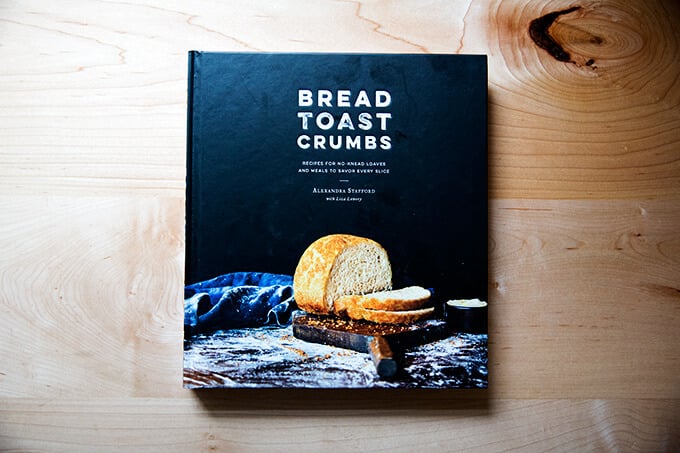









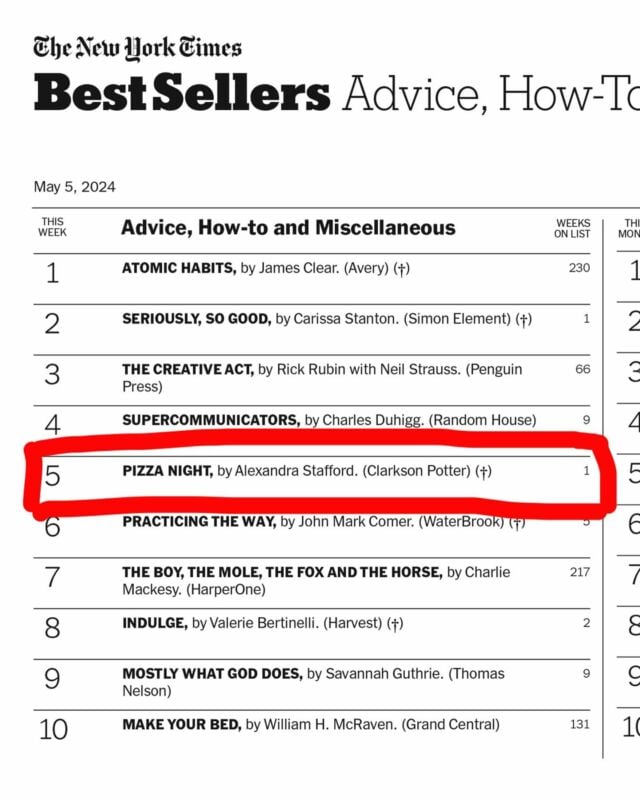



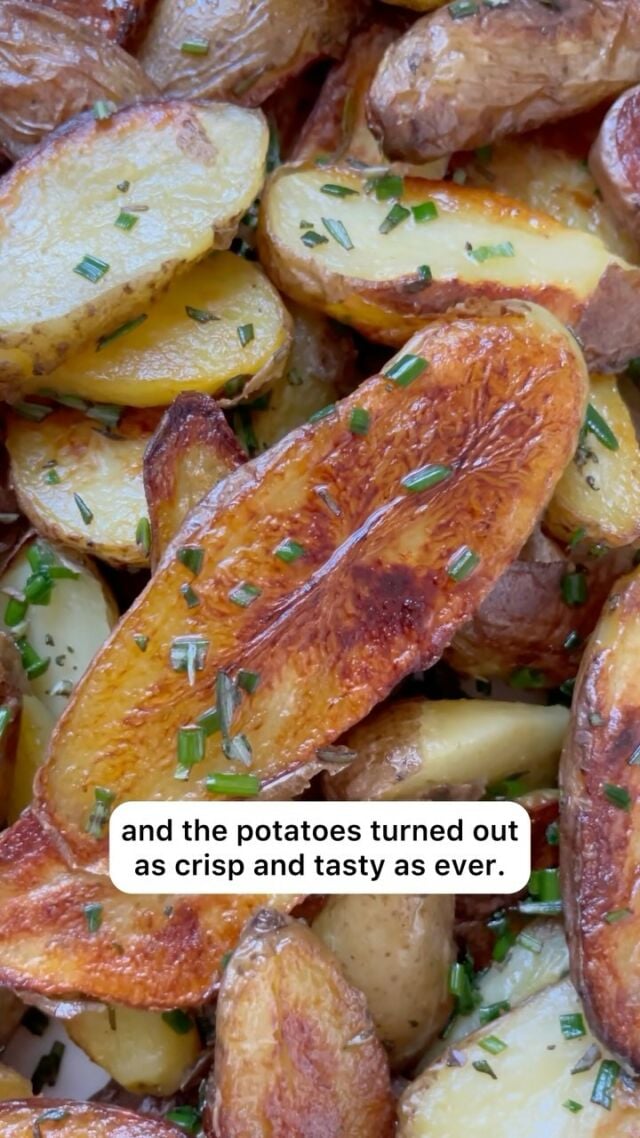




6,417 Comments on “My Mother’s Peasant Bread: The Best Easiest Bread You Will Ever Make”
Made this after reading your sourdoughpost. I subbed 100g of fresh strong discard for 50/50 flour and water. Super easy and great tasting bread! I didn’t have quart Pyrex so I divvied it between 3 ramekins and 2 mini loaf pans. I will be making this again!
Wonderful! Thanks so much for writing and sharing this 🙂 🙂 🙂
Hi. Thank you very much for your recipes. love your focaccia! Now I’d really like to make this bread in glass pan. Is there anything I could use instead of butter to make it vegan? Thank you!
Vegan butter works great!
Hi. I love this recipe but was wondering if you could use olive oil instead of butter to grease the bread loaves. I can’t have butter anymore and I live in a country where I can’t get vegan butter. Thank you.
I worry the bread will stick with olive oil alone. You could try coconut oil — in its solid form as opposed to melted.
Fabulous bread and so easy! After the first loaf, I can’t wait to make it again. Everyone loved it. All my 2year old grandson could say was, “Yum..Yum”. It will be fun making it with him next time, which will be sooner than later. Thanks for sharing!
Awwww so nice to read this, Teresa 🙂 🙂 🙂 Nothing like pleasing a 2-year old!
This was so easy and so good! I live in a warm humid climate so the first proof was only 1 hour and I used 2 small loaf tins and they turned out perfectly. Thank you!
So nice to hear this, Corrie 🙂 🙂 🙂
This is the best bread recipe I have ever found. It’s so easy and fast for bread, and healthy with the suggested mods! It’s so perfect. I decided to finally comment after using this recipe fairly consistently for about 3 years I think? I make it basically any time I make broccoli cheese souo. Today I made it it and my underweight partner who is recovering from surgery from a week ago wanted 4 slices after eating 2 grilled cheese sandwiches while the bread was still in the oven! I just had to comment and tell you how much I appreciate you sharing this recipe. It’s so wonderful. I always do half wheat flour and use coconut oil to coat the bowl (my best friend is vegan and loves the bread as well) and always coat the bowl with oats, pepitas, flax seeds, poppy seeds, and sesame seeds, and usually caraway seeds on one loaf for a rye flavor. My partner raves about how delicious it is, and it’s wonderful that it’s so healthy and good that it gets him to eat. ❤️ Thank you with all of my heart. I recommend newbies to the recipe start with less wheat flour than half, or none, and go up in amount a little each time you make it until half. Just in case you don’t like the wheat bread taste, or don’t use the wheat flour at all.
So nice to read all of this, Kristina! Thank you so much for writing and sharing all of your notes; thank you for sharing and encouraging others to make it; and thank you for your kind words. Happy baking!
I was inpired by your everything bagel seasoning idea to try to recreate a Panera cinnamon crunch bagel. It turned out really good! I thought I would share what I did so others could try it. Make streusel by mixing 2 Tbsp. flour, 1/2 c. brown sugar, and 2 tsp. cinnamon, then cutting in 2 Tbsp. butter until crumbly. This is enough for 1 recipe of bread. Divide it between the two buttered bowls by covering the bowl and putting a little extra in the bottom, then saving some to sprinkle on top (which will be the bottom) of the loaves. Proceed with the recipe. Yum!
WOW!! This sounds absolutely outstanding. Can’t wait to try it. Thanks for sharing 🙂
First found this recipe on the King Arthur website. It’s been my go to bread recipe for several years. Just found your website by chance and the variations of this bread intrigue me. Want to make all of them.
Great to hear, Judy 🙂 🙂 🙂
I love this bread, but I’ve made it twice, the second time I even bought SAF instant yeast, and my loaves do not get a good rise. They are small. I let them rise for 1-1.5 hours first rise, and 30 minutes second rise and they are so small!
What am I doing wrong?
Strange!
Are you using a scale to measure? What kind of flour? What size bowls are you using?
Can you use this bread recipe with freshly ground flour?
Hi Lisa: Are you milling the flour yourself? Or buying freshly milled flour?
The answer is yes, but you may need to adjust the amount of water. If you use the full amount of water, you might find yourself with more of a batter than a dough ball. And if you use 100% freshly milled flour you may find the bread to be very dense — I would start with 50% freshly milled flour.
This is the best bread EVER!!!! My husband takes a piece , butters both sides and then fries it!!! OMG!!!!! It’s sooooo good! Made it 3 times in one week!!!!
So nice to hear Diane 🙂 🙂 🙂
Delicious! Thank you so much for this easy and wonderful recipe. I put the bowl on top of the fridge for the first rising. This is my third time making it in three weeks. I plan to try more of your recipes.
Great to hear, Tamara! Thanks for writing 🙂
I think this is the best bread around.
Great to hear, Liane!
Hello
This has been so fun to make! We just love it!
I am out of bread flour. Is it possible to make it with self rising flour?
Great to hear! Possibly: the flavor might be slightly off because there is already a chemical leavener in the flour, but it might be just fine — worth a shot! You’ll still need to add the salt, sugar, and yeast.
Will it still need yeast since it’s self rising?
Yes, I would still use the yeast.
Can I freeze the dough before the second rise?
Yes!
Great recipe! Made it for the first time today and i loved it. I’m far from a baker, but I know baking is more of a science. Is there some way to make different flavors? For simplicity sake, let’s just say adding something like garlic powder. Would that affect anything? If not how much would you recommend for this recipe?
Great to hear Adam! Yes, simply stir the garlic powder in with the flour, salt, sugar, and yeast — I’d start with 1 to 2 teaspoons. Does your garlic powder contain salt?
This did work super well. Nice yeasty tasting bread, which I haven’t had in awhile because I like to use sourdough. But this was super fast and the texture inside will make for great little sandwhiches and snacks.
Great to hear, Jackie! Thanks so much for writing and sharing 🙂
Can the first rise go for longer than a couple hours?
Was wanting to have ready ahead of time but will be gone for a few hours during first rise so I’m curious how long it can go if necessary.
Yes! It’s very forgiving. You can definitely leave it for more than a few hours. If it’s going to be very long, I’d suggest not creating a warm space for the dough to rise — just let it rise on your countertop (covered of course).
Thank you for this fantastic recipe. I struggled with making bread but this was easy and delicious.
Great to hear, Tomi! Thanks for writing 🙂
Hi Alex, thanks for this recipe. I found it and you during covid, when there was no bread in the stores. Thank you. I’ve made this recipe about 8-10 times. On the last time, the dough was not wet like it had been before. I used the same ingredients (same brands of flour, yeast, salt and sugar). Not quite sure what went wrong. When dividing for the baking bowls, the dough was lumpy… didn’t self-level like the wet dough unusually does. Its cold here now and the house between 69-74 degrees. Don’t know if this is a factor. Thanks again for this and many other recipes. I will try again soon; hoping this was just a fluke on my part.
Hi Karen! So nice to read all of this. It likely has to do with the changing seasons and weather/humidity/temperature, etc. If you are not using a scale to measure, that would be my first suggestion. It’s possible you used a heavier hand when measuring the flour this time around and maybe a lighter hand with the water — if you use a scale, it eliminates the human error. But if you are using a scale, it’s possible you simply need to use more water. As the seasons change, the flour changes — even if it’s the same brand — and it might absorb more water than it did even just a few months ago. Hope that helps!
I’ve made this incredible bread several times since finding the recipe. I’ve experimented with it a little. Maybe others will find it helpful.
I made it with all-purpose flour, then half & half with bread flour & then all bread flour. I much prefer it with all bread flour. The crumb is most like store-bought bread, except 1000 times better!
I’ve used rapid yeast & active dry yeast. The bread turns out better with active dry yeast, imo.
I’ve tried the suggestion someone made here, with brown sugar, flour & butter coating the bowl. It makes the crust almost caramelized & tastes amazing, but it doesn’t keep well.
I have a loaf in the oven now with dusted cinnamon & sugar. It smells amazing – I’m sure it will be delicious.
Coating the bowl actually makes the bread inside pick up the flavor. Delicious.
One thing I don’t know if anyone mentioned is that this bread make absolutely amazing toast. Perfect crunch & nooks & crannies for the butter!
Thanks so much for the recipe. It’s so easy to make & it turns out delicious every time!
Great to read all of this, Nikki! Thanks so much for taking the time to share all of your notes 🙂
I love your Peasant bread and always my go to! If I’d like to use einkorn flour – would I just swap out the same amount of APF or bread flour for einkorn? Even spelt flour? Thank you!
Yes, that should work OK. The dough may be a little wetter initially, but should thicken as it rises. Spelt flour is fine, too!
I love this recipe! My question though is if I double the batch do I the yeast as well? My grandmother says I use too much for only 2 loaves so I’m wondering if it would make s a difference to just use the one packet for a double batch.
You could definitely get away with using one pack for a double batch. Go for it 🙂
Works every time!
Great to hear, Kathy!
I just tried the peasant bread after making the focaccia several times…and it was met with rave reviews but I do have a couple of questions..it seemed almost gummy in the middle but I know it was cooked through…I did the press test and it sprung back just right..the other thing I noticed was that it had a vinagery smell…is that the yeast coming through because I used active, dry yeast (a full packet)? Lastly, I used a 2 qt glass bowl and did not split it but it did not rise much more at all in the baking..it stayed pretty much the same as the 2nd rise height. Sorry for all the questions but would love your thoughts… 🙂
Hi Gina!
Questions: are you using a scale to measure? What type of flour are you using?
It’s possible the yeast you are using is causing the smell. My suggestion would be to invest in SAF instant yeast — it will keep for a year in the fridge or freezer.
Regarding the rise, it’s possible in that size bowl you need to let the dough rise for a longer period of time — it should crown the rim of the bowl. In the winter, dough rises more slowly, so next time I suggest just being a little more patient. The gumminess you experienced could be because the dough was insufficiently proofed.
Thank you so much for replying!!
I did use bread flour (King Arthur) and I also used a scale. When it rose for the 2nd time…it came to just the edge but it did not crown it so perhaps I just needed to let it go awhile longer…I did read in the notes where it shouldn’t take 2 hours so I guess I was too “married” to the 1 hour rise time. I am making it for Thanksgiving but I am going to make it the day before. Thank you!!
Hate to ask yet another question but I used a mixer with a bread hook…I use it all the time for bread and pizza dough but just thought I would ask your thoughts with the peasant bread…worked fine with the focaccia…
If that’s your preferred method, go for it. It’s such a high hydration dough that it doesn’t seem necessary, but if you like to use your mixer, that’s great!
Very excited to try this recipe. My dough is now rising. I only have a large Pyrex casserole dish. Should I do it at the 450 and then reduce heat after the 15 minutes? Or should I cook it at 375 for 45 min?
Thank you!
Sorry for the delay! So glad the bread was a success. Thanks for reporting back!
So good! Thank you for sharing! I baked it in a large Pyrex casserole dish at 375f for 45 min. DELICIOUS!
Great to hear, Jocelyn!
If using the dutch oven method, do I bake on 450 after preheating the Dutch oven? Or do I return to the main recipe and bake on 425?
Keep it at 450 🙂
Best bread I ever made – I make this all the time and tell everyone about it!
That buttery crust is unreal!
Thank you! 🙂
Great to hear, John! Thanks for writing 🙂
This has been my go-to peasant bread recipe for years. I love how easy it is. We don’t have a bread machine so I love that this is so simple. My family loves the nice crust with soft insides. Thank you for sharing!!
So nice to hear, Rachel! Thanks for writing 🙂
Alex, I am making this bread today to use in your classic stuffing. I don’t have the 1 or 1 1/2 round but I do have 2 pyrex loaf pans. They are 11/2 each. I am unclear as to why you recommend 1.5 times your recipe for 2 loaf pans yet the round bowls can be 1 or 1 1/2. Please clarify this for me. Luckily this bread recipe is quick, I hope you have time to respond today. Thank you.
Hi! The increased ratio is mostly so that you get a nice tall loaf — you absolutely can use your loaf pans with the peasant bread recipe as written, but you’ll just have two short loaves. They’ll still be delicious/taste exactly the same as when baked in the bowls. People sometimes just think they’re doing something wrong if the loaf doesn’t turn out looking like a tall sandwich loaf, so I often suggest making 1.5x the recipe for loaf pans to achieve the look people are expecting. Hope this makes sense!
Alex, thanks so much for your prompt reply. The first rise is just about ready for the pans, perfect timing! Since I am making your classic stuffing with these loaves, the shorter loaves won’t matter too much especially since your recipe calls for 1 1/2 loaves. I’ll have the option of using the inside soft bread of both full loaves and then balance out the remaining12 cups with the crusts. Happy Thanksgiving, thank you for developing and posting these lovely, proven winners.
Happy Thanksgiving to you, Denise! Thank you for your kind words 🙂 🙂 🙂
I make peasant bread all the time. I want to make it using wheat flour. Do I need to change the amount of water? If so how much? Does it need rise longer? My family loves this bread. Thank you for sharing the recipe.
Hi! You shouldn’t need to change anything. Often when using whole wheat flours, you need to add more water, but this is such a high hydration dough, you shouldn’t need to. Rising times should be roughly the same, though yes, you may need to increase it slightly as the whole wheat dough will be a little heavier and, with less gluten, the dough may take longer to rise. Do keep in mind a 100% whole wheat flour peasant bread will be denser in texture. Still tasty! Just not as light. You can also do 50% whole wheat, 50% ap flour … or really any ratio you wish 🙂